
Lezli Harrell, Vice President at COPC Inc., takes an in-depth look at how leaders can improve employee engagement to drive a better customer experience and achieve greater customer loyalty.
You know the old adage, “happy employees = happy customers.” It’s been around a long time but it’s being put into practice more today than ever. Leading this effort is the increased role that customer experience (CX) plays as a key differentiator, particularly with increasing competition and customer expectations. So, it makes sense that focusing on the heartbeat of the organization – the employees – is more important than ever to keeping customers happy and contributing to the success of the organization.
That is where employee engagement comes into the picture. Service journey mapping, channel strategies, self-service initiatives, and digital transformation are all important to developing and delivering a more pleasant and effortless customer experience. But the importance of the human element cannot be relegated to a mission statement or poster on the wall.
Organizations must recognize the impact that employee engagement has on the customer experience, and therefore on overall success. Employee engagement initiatives must be woven into broader CX strategies, linking the two together to truly achieve desired results.
This article will establish the foundation for:
- What employee engagement is and what it is not
- Why employee engagement is important to the customer experience
- How leaders can improve employee engagement to drive a better customer experience
What employee engagement is and what it is not
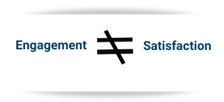 To focus on employee engagement, it is important to understand what it is while also considering what it is NOT. Simply put, engagement does not equal satisfaction.
To focus on employee engagement, it is important to understand what it is while also considering what it is NOT. Simply put, engagement does not equal satisfaction.
What does this mean exactly? For example, an agent may be perfectly satisfied with their schedule, level of pay, their manager and the work they do. They show up to work, do their job, follow processes and when asked to fill out an employee satisfaction survey, they say they are “satisfied.” They go through the motions meeting minimum requirements because the work meets their basic needs; however, they do not go above and beyond and if they had a ‘better’ offer, they would not hesitate to consider it.
Conversely, an actively engaged employee is clearly committed to their work and the organization and consistently goes the extra mile to exceed performance expectations. Contrary to the “satisfied” agent in the above scenario, an engaged agent is enthusiastic about their work, believes in the organization, is an active participant in the team’s success, proactively seeks ways to improve their own performance and collaborates with their manager and teammates on how to serve customers better. Most importantly, they are brand ambassadors for their company. This enthusiasm is evident to customers on the other end.
Put yourself in the customer’s shoes. Which agent would stand out to you? Which agent would you rather interact with if you had your choice? And which one would give you confidence that you are doing business with a brand that cares about their customers? The answers should be clear.
In summary, an engaged employee is always satisfied, but a disengaged employee can also be satisfied. This can produce two vastly different results, for both the customer and the business.
So, what exactly is employee engagement for purposes of this discussion? The definition in this Forbes article from several years ago still applies and should serve as the foundation for the rest of this discussion:
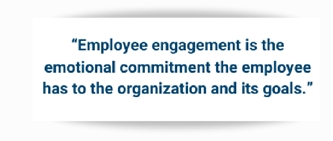
How do you know if your employees are engaged?
It makes sense that organizations strive to create an environment that fosters this level of commitment and passion. The challenge becomes understanding if employees are in fact engaged. Employee surveys can provide a quantified measure of employee engagement. Intangible characteristics provide an even better measure of engagement. We share six questions to ask yourself to gauge the level of engagement among your workforce:
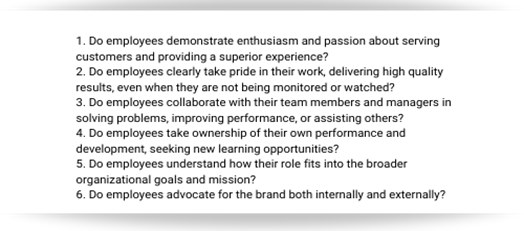
The common thread throughout these questions goes back to the original definition, which is assessing if employees have an emotional and passionate commitment to achieving high performance and delivering excellent service. If you find the answer to some or all of these questions is no, then you know you have an opportunity to improve employee engagement.
Why is employee engagement important to the customer experience?
Most leaders would agree that employee engagement is important to the customer experience and therefore the organization’s overall success. The statistics below highlight the importance of making employee engagement a priority as part of the broader CX strategy:
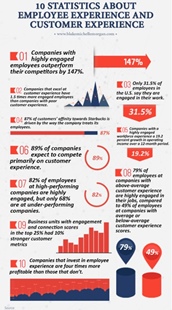
- Companies with highly engaged employees outperform their competitors by 147%
- Seventy-nine percent of employees at companies with above- average customer experience are highly engaged, compared to 49% of employees at companies with average or below-average customer experience scores
- Companies with an employee engagement program experience 233% greater customer loyalty
- Companies with robust employee engagement programs are seven times more likely to link employee performance with good customer experiences
- 3X more likely to feel extremely empowered to resolve customer issues
Additionally, employee retention is higher and absenteeism is lower with an engaged workforce. In fact, engaged employees are 8.5X more likely to stay than leaves within a year, and they have 81% lower absenteeism. Obviously, this has a positive impact on the bottom line from a cost perspective, but also contributes to a better and more consistent customer experience.
The numbers speak for themselves, proving the strong link between high employee engagement and customer experience. The passion, enthusiasm and commitment to excellence demonstrated by engaged employees will be infectious to customers and produce the competitive differentiator so critical to the organization’s long-term success.
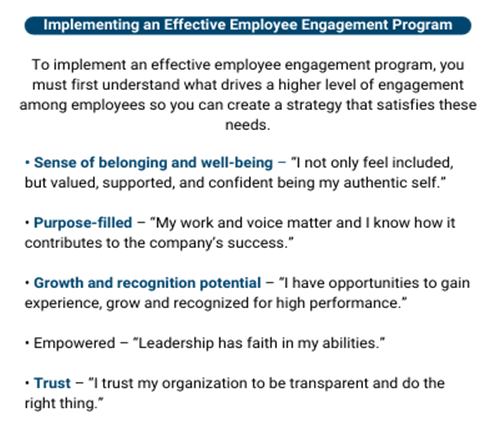
With these drivers as the backdrop, what can you do to build a culture and strategy that truly weaves employment engagement into the fabric of your organization and the broader CX strategy?
Peter Drucker made this quote famous and it is certainly true in this context – “Culture eats strategy for breakfast.” Organizations often believe they have the right strategy with the best of intentions, but their culture does not support it. It is “easy” to say that customer and employee experience are important, and it may even be part of a mission statement. But if culture and actions do not align with the strategy, more harm than good is done.
High-performing organizations spend time creating company values, linking employee engagement and customer experience behaviors together. These values and behaviors then become woven into every aspect of the organization.
Trader Joe’s is an excellent example of an organization that has built their brand around employee engagement, creating a loyal following with a distinct and consistent customer experience, regardless of location. They defined seven key values that govern employee and company behaviors – in short, they translate values into specific behaviors they expect of their leaders and employees. How do you do this?
Below are eight ways to ensure your culture, strategy and behaviors link employee engagement to customer experience:
1. Communicate values and expected behaviors – Ensure employees understand key values and the behaviors that support those values. As discussed earlier, engaged employees feel connected to the organization’s success and have a clear understanding of how and why their work matters. Clearly explain the value of their work, how it fits into the bigger picture and why what they do is important. To reinforce this, consistently provide specific examples of how their performance contributes to the company’s success so they continue to feel connected.
2. Create employee engagement opportunities – Day-to-day engagement, in the form of active team participation and the proactive pursuit of improvement opportunities, is the goal and must be driven by all levels of leadership. Other means for employee engagement are also important, such as structured focus groups, team events, networking groups, special interest opportunities, company-sponsored charity opportunities, lunch-and-learns, “meet your VP” and team collaboration are all ways to encourage engagement and foster inclusion.
3. Develop a robust and closed-loop employee feedback system – This goes beyond a simple measurement of employee satisfaction, seeking ideas and input from employees that support the company’s mission. Yes, measuring employee satisfaction and acting on the feedback is critical; however, just as important is actively seeking employee ideas and feedback, communicating results, implementing action plans and communicating specific actions taken and the results.
4. Tie performance reviews and recognition programs to company values – If employee engagement and customer experience are linked as part of the company’s values, incorporate them into all aspects of performance management and recognition. Seek 360-feedback from peers and other leaders focused on how the employee demonstrates company values and is an engaged member of the company. Create special award programs which recognize employees who demonstrate specific company values, going above and beyond to be engaged both internally and with customers. The bottom line is to expand these programs beyond performance. There should of course be a performance component, but to build a culture of engagement, these activities and characteristics must also be equally measured and recognized.
5. Communicate transparently and frequently – To foster an environment of trust, organizations must communicate clearly, frequently and consistently. Engaged employees want to feel part of something. They want to know the strategies so they can contribute. They want to know of any challenges the company faces so they can be part of the solution. Trust can erode quickly and be hard to recover; ineffective communication is one of the biggest drivers of lack of trust. A communication strategy must be developed from the top down to include company “town halls,” department strategy and performance updates and team meetings that ensure alignment and understanding.
6. Provide growth and development opportunities – This goes beyond standard new hire training, coaching or upskilling. All of those are important to an employee’s feeling of accomplishment, but engaged and loyal employees want to have real opportunities to grow and develop. They want to feel as if the company is invested in them and their future. This requires a structured development program governed by Human Resources, trained to all leaders and implemented at all levels. Starting with coaching, all leaders must be hired and trained to be effective coaches. This is different from providing “feedback” and focuses on helping employees be the best they can be. Structured training is of course a fundamental component of development, but managers should be empowered to seek other opportunities to help employees develop skills in areas of interest. For example, structured mentor programs, external webinars, bringing in an outside (or internal) expert or providing ability to shadow in other departments.
7. Implement adequate tools – Tools play a critical role in an employee’s success. Of course, a great tool cannot fix a poor process, but nothing is more frustrating to employees who want to do an excellent job but are hindered by ineffective tools. Tools that support customers such as knowledge bases, CRMs and even AI-powered solutions to assist agents are obviously important. Collaboration, coaching, and support tools are also critical especially in the current environment which consists of large work-from- home workforces. Simply put, employees need tools to support customers and to remain connected to peers and management.
8. Prioritize employee wellbeing – All of the above contribute to an employee’s wellbeing. At the end of the day, employees want to feel secure, supported, and confident to perform to the best of their abilities. Contact center employees have experienced significant changes since the start of the pandemic so it is no surprise that many are feeling stressed. Feelings of isolation have also mounted due to the pandemic and ongoing work-from-home (WFH) staffing models. Organizations should consistently evaluate internal and external support resources available to employees and encourage the use of them. For example, increasing available resources related to mental health, financial advice, and fitness/wellness programs all play a vital role. Some organizations are even going as far as paying additional incentives for vacations (however, if vacation is not taken, employees are ineligible to receive that benefit.) Additionally, work-life balance has become a priority for many employees. Organizations need to recognize this and truly embody it. This means establishing “ground rules” for after-hours meetings, emails, and the like. This is all to promote overall wellbeing, both mentally and physically.
Conclusion
The time is now to embrace the importance of employee engagement and to ensure it is woven into the fabric of organizational culture. The facts are clear – more engaged employees mean higher customer satisfaction and increased profitability. Organizations that take the next step to link engagement and customer experience together will achieve the ultimate goals of transforming their customers’ experience, standing out among competitors and creating positive environments for employees.
About the Author
 Lezli Harrell is a Vice President with COPC Inc., an innovative global leader that provides consulting, training, research, and certification for operations that support the customer experience (CX). For over 20 years, she has worked with brands all over the world to improve CX operations, optimize processes and performance, and implement best practices that drive bottom line results.
Lezli Harrell is a Vice President with COPC Inc., an innovative global leader that provides consulting, training, research, and certification for operations that support the customer experience (CX). For over 20 years, she has worked with brands all over the world to improve CX operations, optimize processes and performance, and implement best practices that drive bottom line results.




